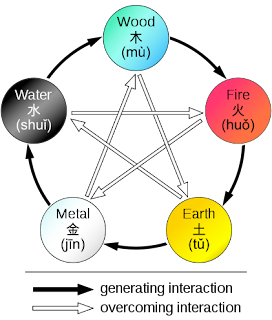Just a little more thought on the Taoist (Daoist) Motions, commonly called Elements for use as saving throw types for Flying Swordsmen.
Wood (Yang) - Generative: strength, flexibility, cooperation, growth, life
Fire (Yang) - Expansive: dynamism, persistence, heat, agression
Earth (balance) - Stabilizing: stability, conservation, empathy, harmony
Metal (Yin) - Contracting: rigidity, control, materialism, transformation
Water (Yin) - Conserving: stillness, intelligence, softness, fear/calm
So how to best use this in an RPG context, specifically a D&D-based context? First was deciding which element to replace each traditional save category. That was fairly easy.
Death/Poison/Paralysis is now Wood. Your vitality/life force counteracts these negative forces.
Magic Wands is now Water. This one ended up actually by default, but since there aren't magic wands in the game, there wasn't really anything for this save to do, besides 'unofficial uses' like saves vs. traps and stuff. And in that context, your stillness/calm can save you from getting decapitated by the spinning blades or from plunging feet first into a pit trap, so it sorta makes sense.
Petrification/Polymorph is now Metal. Your affinity for Metal prevents you from being transformed to another shape/substance against your will.
Dragon Breath is now Fire. Your dynamic nature and persistence allow you to avoid or resist area attacks and heat (and come on, despite there being 5 basic types of dragon breath, don't we usually imagine a fiery blast of dragon breath by default? I know I do.)
Spells is now Earth. Your stability and harmony with nature, not to mention balance of Yin/Yang, becomes the default save vs. magic without any type, and against many unusual monster attacks.
How they work in play:
First of all, if a spell has an element type listed, use that element to save. Second, all spells are labeled as Yin, Yang, or Chi. If there's no element to override Yin/Yang association, use the better Yin or Yang value for your class. Chi spells only have one save to use, Earth.
Now to tinker with the numbers for the classes. Traditionally, every class in D&D is best at saving against Death/Poison, and worst against either Spells or Dragon Breath. That will be changed. I'm currently thinking about which element to assign as best to each of the 4 classes. Here's the best I've got so far:
Fighter: strongest in Wood. High hit points, lots of vitality and strength.
Wizard: strongest in Metal. Control and transformation being the key points of magic, this seems to fit to me.
Shaman: strongest in Water. Stillness and conservation seem to fit the image of the Shaman/Cleric.
Thief: strongest in Fire. The image of the Thief is one of action and motion contrasted with patience and perseverance.
I may also consider using Earth for the Shaman and then Water for the Wizard, but I kinda like the idea of keeping Earth as the default "everyone sucks at this, and any attack that doesn't fall into another category goes here" save, like traditional Save vs. Spells. So I'm probably going to go with the above.
Now, the final question I'll have to decide. Once the 'best' save is set, do I order the other saves by the generative motion (circle in the image above) or the opposition motion (star in the image above)?
Forward into the Past
47 minutes ago







GM: Make your saving throw vs. Metal.
ReplyDelete"Hey Butt-Head, he said 'save vs. metal.' That's pretty cool. Heh-heh, heh-heh"
ReplyDelete"Shut up, Beavis. I'm trying to save vs. wood."
*golf clap*
ReplyDeleteLet it not be said that I won't be the first one to disparage my own good ideas with toilet humor.
ReplyDeleteThis is a really cool idea. I don't know how (or if) I could use it, especially since other than one class on the history of Asian scroll painting many years ago my knowledge of Asian culture is weak, weak, weak, but I like the logic and the consistency.
ReplyDeleteAre different spells tied to the different elements? So perhaps a spell from the 'wood' class could be overcome/prevented/nullified by a spell from the metal class and vice/versa? Just a thought.
This is awesome.
ReplyDeleteSo, you're going to do your own version of Ruins & Ronin and incorporate the Five Motions saving throws? :D
ReplyDelete@Theodric, I haven't taken a really good look at R&R, but I was under the impression from Mike's old Sword +1 blog that it was basically OD&D with a Japanese paint-job. That's not to disparage it. The original OA was basically AD&D 1E with a Japanese paint-job, and 3E OA was 3E with a Japanese paint-job.
ReplyDeleteFlying Swordsmen is a simulacrum of Dragon Fist, which was AD&D 2E with a Chinese paint-job. I've cut out some of the annoying (to me, I realize) AD&D aspects, so my game will be closer to a Classic D&D/AD&D hybrid with a Chinese paint-job. The biggest difference from standard D&D/AD&D is that every class gets martial arts that improve as you level.
@Limpey, That's likely going to get to complex. Basically, if the spell is a "fire" spell you save vs. fire. If it's a "water" spell you save vs. water. KISS principle at work.
ReplyDeleteAnd not every spell has an element, but all have Yin, Yang, or Chi associations. Some also have elements. Certain monsters are aligned to specific elements as well, so their attacks would count as that element unless specified otherwise in the ability description.
Dragon Fist! I don't know how I missed that before. I blame it on a head injury.
ReplyDeleteIn any event, I watch with interest and throw out occasional cheers!